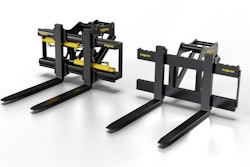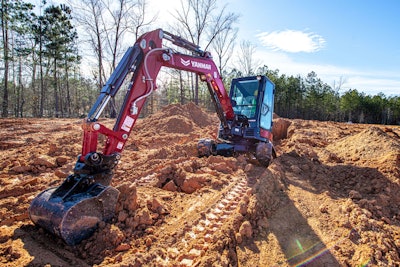
Sales continue to rise for compact excavators, partly driven by a strong housing market. And that’s likely to continue.
“Compact excavators have seen double-digit year-over-year sales increases for quite some time,” says Ryan Anderson, product marketing manager, New Holland Construction, “and there’s no indication they will slow down.”
Not even the pandemic hindered sales.
“Covid will have skewed the five- and 10-year economic data for a long time,” says Aaron Kleingartner, product and dealer marketing manager, Doosan, “but compact excavators seem mostly unaffected. It may be that Covid drove contractors to smaller jobs requiring compact equipment.” But, he says, that’s just speculation; the full effect of Covid is complex and defies simple analysis.
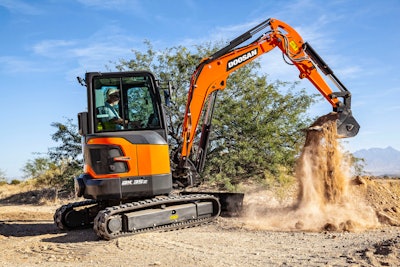 Three of the four new models of Doosan’s -7 compact excavators, including the DX35Z-7 shown, feature zero tailswing. A fourth, the DX55R-7, has a reduced tailswing. An integrated additional counterweight enhances structural durability while allowing offset digging without the need to reposition the machine. All -7 compact models come with enclosed cabs and optimized HVAC.Doosan Infracore North America
Three of the four new models of Doosan’s -7 compact excavators, including the DX35Z-7 shown, feature zero tailswing. A fourth, the DX55R-7, has a reduced tailswing. An integrated additional counterweight enhances structural durability while allowing offset digging without the need to reposition the machine. All -7 compact models come with enclosed cabs and optimized HVAC.Doosan Infracore North America
As the effects of Covid wane, other factors have emerged.
“Equipment lead times and projections are difficult,” says Bart DeHaven, director of sales, Kato CES. “The general economy, interest rates, the return to suburbia, inflation and the stock market will all affect demand in the coming days.” He expects another 18 months of low equipment inventories. Despite that, he believes current market conditions are sustainable for the next two to three years.
And the future?
“There remains a shortage of housing inventory,” says Greg Worley, Cat marketing professional, global mini excavator. “Growth of housing and, therefore, compact equipment will continue until that demand is met.”
Reasons to buy now
Jeff Pate, North America director of sales, Yanmar, says new machine warranties are longer and more comprehensive than in the past.
“If your current compact excavator is out of warranty, getting a new machine with a fresh warranty can itself be a compelling reason to buy.”
Many models come with free telematics for a specified period.
As to when you should turn in your old machine, compact excavators have wildly varying utilization rates and therefore wildly varying replacement cycles.
“There is no typical or average replacement schedule,” says Pate. “It may be from three to seven years or even longer. You have to weigh all the factors and decide on a case-by-case basis.”
Compact excavator prices have also not seen the large price increases as heavy equipment. Anderson says competition in the compact equipment market has helped minimize increases, but that might not last.
“The challenge will be for manufacturers to keep prices manageable as prices for steel, semiconductors, rubber and other commodities rise,” he says.
 Komatsu’s PC88MR-11 has standard high-flow auxiliary hydraulics with proportional joysticks. The reduced tailswing radius and faster boom and arm speeds boost production in confined spaces and urban settings. The new high-efficiency power package and viscous cooling fan reduce fuel consumption by up to 13%.Komatsu
Komatsu’s PC88MR-11 has standard high-flow auxiliary hydraulics with proportional joysticks. The reduced tailswing radius and faster boom and arm speeds boost production in confined spaces and urban settings. The new high-efficiency power package and viscous cooling fan reduce fuel consumption by up to 13%.Komatsu
Jonathan Tolomeo of Komatsu doesn’t see prices coming down soon either. He notes that interest rates are also rising, so waiting will almost certainly result in higher rates.
“Those rising interest rates and the housing inflation crisis may well put a damper on housing at some point,” says Tolomeo, “but other markets that use compact excavators, including utilities and infrastructure, are less sensitive to inflation and interest rates. Those markets are strong now and will likely remain so.”
And inventories are low. Dealers cannot guarantee having the just-right machine with so few machines available, so they have become more creative in providing value for customers.
“Dealers have made it easy to get everything you need from a single source,” says Justin Steger, solutions marketing manager for site development and underground, John Deere. A range of buckets and attachments is available, and Deere also now offers Engcon tiltrotators through its dealers. Everything is paired, packaged to work together and available as a single transaction.
Steger adds, “Using your compact excavator for many tasks fits with the idea of doing more with less.”
This extends to the number of employees a contractor has, he says. “We’re not trying to reduce the size of the workforce, but we are recognizing the shortage of skilled operators and the stress that puts on contractors.” Getting peak utilization from each piece of equipment in the hands of lesser-skilled operators becomes crucial.
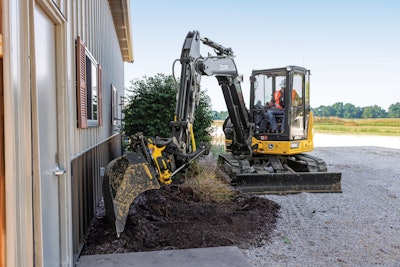 The John Deere 60G has an operating weight of 13,620 pounds and is powered by a Yanmar engine rated at 53 horsepower. The reduced tailswing design (4-foot 3-inch tailswing radius) make the 60G suitable for use in compact areas while still delivering up to 9,240 pound-feet of bucket breakout force and a dump height of 13 feet 8 inches. The available Engcon tiltrotator further enhances the 60G’s versatility.John Deere
The John Deere 60G has an operating weight of 13,620 pounds and is powered by a Yanmar engine rated at 53 horsepower. The reduced tailswing design (4-foot 3-inch tailswing radius) make the 60G suitable for use in compact areas while still delivering up to 9,240 pound-feet of bucket breakout force and a dump height of 13 feet 8 inches. The available Engcon tiltrotator further enhances the 60G’s versatility.John Deere
Whether you buy now or wait, Dan Collins, product development and marketing manager, Kobelco USA, says you should weigh other factors when making a decision.
“When companies have multiple projects that would lead to rental costs of 50% or more of purchase price, it likely makes more sense to purchase a machine.” He says the customer’s financial capacity and workload forecast play key roles in the decision to buy a new machine but adds, “This is different for each customer.”
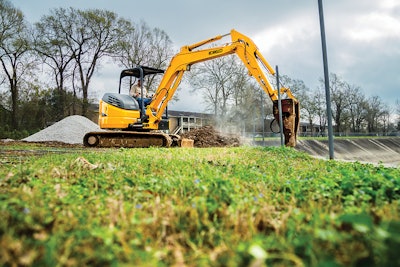 The SK55SRX-6E from Kobelco is a short-tailswing model with the company’s Integrated Noise & Dust Reduction (iNRr), which also makes it easier to clean the cooling system. S mode allows fuel savings of up to 23%, and one-touch deceleration saves fuel when the machine is at rest. The blade design delivers dozer efficiency when grading.Kobelco
The SK55SRX-6E from Kobelco is a short-tailswing model with the company’s Integrated Noise & Dust Reduction (iNRr), which also makes it easier to clean the cooling system. S mode allows fuel savings of up to 23%, and one-touch deceleration saves fuel when the machine is at rest. The blade design delivers dozer efficiency when grading.Kobelco
Reasons to wait
Industry sources are focused on sales, and it isn’t in their nature to offer reasons to not buy their products. “There is no reason to wait,” says Pate. “If you can find the machine you want, buy it.” We did get a different take from some, however.
Just as Collins cites rental as a factor in a decision to buy now, he says rental is an option for those choosing to wait.
“Renting can be the right choice when the future needs for the machine are unknown.” He says rental also helps manage costs by eliminating repair and maintenance expenses.
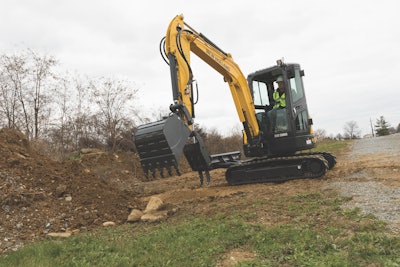 New Holland’s E37C has a Yanmar engine rated at 24.4 gross horsepower and pilot-operated hand controls plus foot pedals. Operating weight is up to 8,660 pounds with a cab, long arm and additional counterweight. The swing boom moves 75 degrees left and 50 degrees right. Standard two-speed travel provides a maximum travel speed of 2.6 mph and maximum gradeability of 30 degrees (58%).New Holland
New Holland’s E37C has a Yanmar engine rated at 24.4 gross horsepower and pilot-operated hand controls plus foot pedals. Operating weight is up to 8,660 pounds with a cab, long arm and additional counterweight. The swing boom moves 75 degrees left and 50 degrees right. Standard two-speed travel provides a maximum travel speed of 2.6 mph and maximum gradeability of 30 degrees (58%).New Holland
Anderson, of New Holland, says machines coming off lease and rental make a good option for customers seeking equipment but unable to find what they want among new inventory or unable to justify the cost of new.
He adds, “If what you have works for your purposes, keep it. Be aware that you may be missing a performance parameter if your scope of work is changing or if you’ve been marginally spec’ed all along.”
Michael Bennett, product portfolio manager, LBX Link-Belt, says, “If a contractor doesn’t have the demand or backlog of jobs to keep a compact excavator working, cost of ownership could get out of balance.” (Of the dozen excavators in the Link-Belt lineup, two are less than 10 metric tons operating weight, the 75 X3 and 80 X3.)
That backlog must also be of the type of work that suits a compact excavator.
“Compact excavators do niche-type work: footers, shallow utility installation, sewer and septic, and they do it in tight work spaces,” he says.
If a contractor’s backlog includes full basement excavation for a 200-home subdivision or utility work that goes beyond the range of a compact excavator, “the contractor should maybe question the choice of a compact machine.”
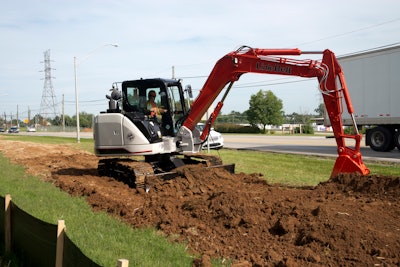 The 18,900-pound Link-Belt X3 SA is powered by an Isuzu AP-4LE2X engine rated at 54 net horsepower. Max dig depth is 13 feet 9 inches, and reach at ground level is 22 feet 9 inches. Arm force is 8,880 pound-feet, and bucket digging force is 12,800 pound-feet. Bucket capacities are 0.24 to 0.71 cubic yards, heaped. RemoteCARE telematics are now included at no additional cost.Link-Belt
The 18,900-pound Link-Belt X3 SA is powered by an Isuzu AP-4LE2X engine rated at 54 net horsepower. Max dig depth is 13 feet 9 inches, and reach at ground level is 22 feet 9 inches. Arm force is 8,880 pound-feet, and bucket digging force is 12,800 pound-feet. Bucket capacities are 0.24 to 0.71 cubic yards, heaped. RemoteCARE telematics are now included at no additional cost.Link-Belt
Given the current imbalance between supply and demand, Patrick Baker, Kubota product manager, construction equipment, says, “Customers may have to settle for an excavator they may not have intended to purchase originally.”
Whether to settle and have a less-desirable machine now or wait in hopes of a better-matched model later takes careful analysis. Part of that analysis is that “customers are dealing with the highest inflation in the last 50 years,” notes Baker.
Mike Fitzgerald, Bobcat marketing manager, product planning, says the best guidance for deciding whether to buy a machine is utilization rate:
“Does your utilization rate justify owning or renting? Are you renting compact excavators? How often and for how long? Are you putting off or declining work because you lack machines?”
 The Bobcat E60 R2-Series is available in long-arm and extendable-arm configurations with operating weights of 12,315 and 12,646 pounds. Dig depths are 13.1 and 14.8 feet; dump heights are 14.3 and 15.2 feet. Both have 55-horsepower engines and swing booms with 75 degrees left and 55 degrees right swing. They are conventional tailswing machines.Bobcat
The Bobcat E60 R2-Series is available in long-arm and extendable-arm configurations with operating weights of 12,315 and 12,646 pounds. Dig depths are 13.1 and 14.8 feet; dump heights are 14.3 and 15.2 feet. Both have 55-horsepower engines and swing booms with 75 degrees left and 55 degrees right swing. They are conventional tailswing machines.Bobcat
Electrification
Compact excavators are ideal candidates for one emerging trend: electrification.
“Electrification is coming first to compact equipment due to current battery and infrastructure capabilities,” says Darren Ashton, product manager compact equipment, Volvo Construction Equipment.
He cites the Volvo ECR25 Electric as an example of this trend. It is equipped with lithium-ion batteries and one electric motor to power the hydraulics for both travel and work circuits. Electric models are quiet and fume-free, making them well suited for indoor demolition, work in urban areas, food production and high dust environments.
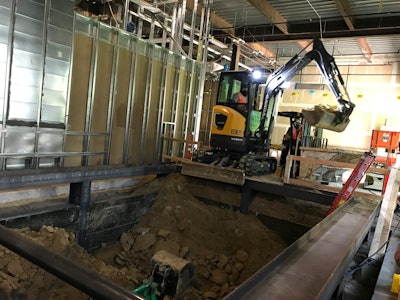 Operating weight for the Volve ECR25 electric compact excavator is up to 6,129 pounds. Peak power for the electric motor is 24 horsepower. Maximum digging depth with the long arm is 9 feet 1 inch, and arm breakout force is 3,993 pound-feet. Charge times for the 48 V 20 kWh battery is around 5 hours on-board with 230 VAC 16 A or around 50 minutes to 80% charge off-board with a 400 VAC 32 A charger.Volvo CE
Operating weight for the Volve ECR25 electric compact excavator is up to 6,129 pounds. Peak power for the electric motor is 24 horsepower. Maximum digging depth with the long arm is 9 feet 1 inch, and arm breakout force is 3,993 pound-feet. Charge times for the 48 V 20 kWh battery is around 5 hours on-board with 230 VAC 16 A or around 50 minutes to 80% charge off-board with a 400 VAC 32 A charger.Volvo CE
Bobcat is among the OEMs rolling out electric equipment; it’ll have two battery-operated machines in 2022. “If the nature of your work indicates the use of electric machines and you’re loyal to the Bobcat brand or your Bobcat dealer, check with your dealer regarding availability,” Fitzgerald says.
Kato offers the 17VX and 9VX in both battery and corded electric models (approximately 1.7 and 0.9 metric tons, respectively). Sales are strong and these machines represent the largest growth by percentage for Kato, says DeHaven.
Some manufacturers, however, don’t see the North American market as ripe enough yet for electric compact excavators. Yanmar’s SV17e is an electric model not available in North America and with no current plans to bring it here. The 1.5- to 2-metric-ton-class machine has 48-volt fast-charge capability and good performance specs, “but the actual demand for electrics lags supply at this point,” says Pate. “The number of early adopters is low.”
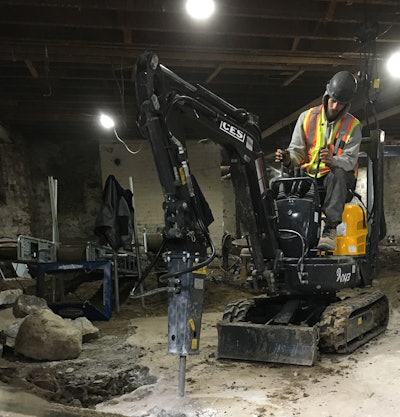 A lithium-ion battery pack provides up to 8 hours of operation of the Kato 9VXB compact excavator. No battery memory means the 9VXB can be recharged at any time; a 3-hour fast-charge system is available. The expandable undercarriage offers variable widths of 27.5 to 37.5 inches. Bucket capacity is 0.8 cubic feet; operating weight is 2,060 pounds.Kato
A lithium-ion battery pack provides up to 8 hours of operation of the Kato 9VXB compact excavator. No battery memory means the 9VXB can be recharged at any time; a 3-hour fast-charge system is available. The expandable undercarriage offers variable widths of 27.5 to 37.5 inches. Bucket capacity is 0.8 cubic feet; operating weight is 2,060 pounds.Kato
More advancements
“As machine control technology becomes more affordable and with more sophisticated joysticks, we can expect that compact excavators and their attachments will have more features and greater usefulness in unique applications,” says Ashton.
There is also the steady adoption of technology into all models of compact excavators. Brad Mace, product manager, Case Construction Equipment, says, “an entirely new operator screen and interface that provides advanced controls, machine information and other details is now found on our two largest compact excavators, the CX57C and CX60C,” both of which are in the 5- to 6-metric-ton class.
Other standard features of Case compact excavators include proportional controls, auxiliary flow valve that easily switches between single and bi-directional flow, pattern selector and Auto-Shift. (Features vary by model.) Case has also announced its entry into electrification with the CX15 EV.
Fitzgerald says improved operator comfort, LED displays and touchscreen monitors, preventive-maintenance reminders, rear cameras and quick couplers are among the features pouring into the compact excavator market. If the excavator you’re considering currently lacks these features, it may soon acquire them.
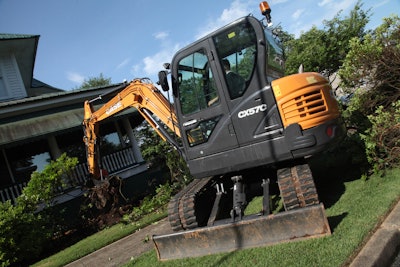 The Case CX57C is driven by a Yanmar 4TNV98C engine rated at 67 horsepower. The counterweight is 220 pounds heavier than standard; that and the conventional tailswing design yield a lift capacity of more than 9,200 pounds from a machine with a 12,270-pound operating weight. Dual operating modes and standard auto idle optimize performance while also saving fuel.Case CE
The Case CX57C is driven by a Yanmar 4TNV98C engine rated at 67 horsepower. The counterweight is 220 pounds heavier than standard; that and the conventional tailswing design yield a lift capacity of more than 9,200 pounds from a machine with a 12,270-pound operating weight. Dual operating modes and standard auto idle optimize performance while also saving fuel.Case CE
Cat sought to future-proof its Next Generation machines. The 306 CR, the first Next Gen compact excavator, arrived with a number of advanced standard features, including greater lift capacity, cruise control and the ability to switch travel control from traditional pedals and levers to joysticks with the push of a button. But the 306 CR is also designed to easily accept emerging and trickle-down tech.
“Big machine features are making their way into smaller models,” says Worley, “sometimes in a package scaled to match the smaller machines. The Next Generation design simplifies the addition of these features as they become available.”
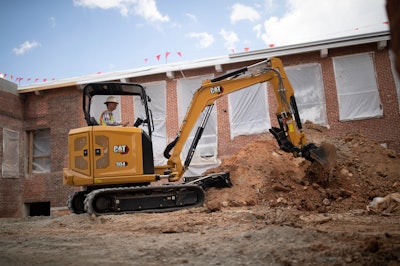 The Cat 304 is powered by a Cat C1.7 turbocharged engine rated at 45 net horsepower. Operating weight is up to 9,867 pounds. A reduced tailswing radius, maximum width of 67 inches and optional stick steer travel mode make it easy to move the 304 around the site. An intuitive Next Generation LCD monitor is standard; an advanced touchscreen monitor is optional.Caterpillar
The Cat 304 is powered by a Cat C1.7 turbocharged engine rated at 45 net horsepower. Operating weight is up to 9,867 pounds. A reduced tailswing radius, maximum width of 67 inches and optional stick steer travel mode make it easy to move the 304 around the site. An intuitive Next Generation LCD monitor is standard; an advanced touchscreen monitor is optional.Caterpillar
Tolomeo says it appears unlikely that Komatsu will bring its full intelligent Machine Control (iMC) package to compacts because compact excavators don’t typically do work requiring such precise grade accuracy. Other upgrades, however, have been included in the PC78US-11 and the PC88MR-11, the first of Komatsu’s Dash-11 compact models.
“We’ve improved the center of gravity for better lift capacities without the need for a larger counterweight,” he says. “Programs can tailor performance to multiple work tools. The blade design now rolls the dirt and keeps it in front of the blade, rather than allowing it to spill over the top, making for more efficient grading and backfilling.”
He adds that the standard swing boom on the PC88MR-1 moves independently of the cab.
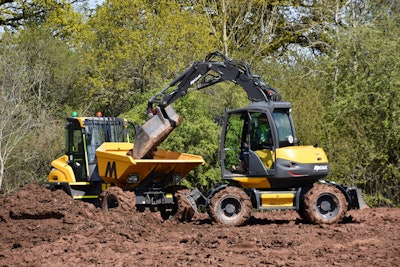 The 9MW holds the middle spot of Mecalac’s three-model lineup of wheeled compact excavators. Operating weight is up to 19,850 pounds, and top travel speed is 22 mph with the standard two-speed drive. Maximum dig depth is 11.5 feet. The three-piece arm facilitates work in low overhead conditions and can dig in both extend (with a loader bucket) and retract (with an excavator bucket) directions.Mecalac
The 9MW holds the middle spot of Mecalac’s three-model lineup of wheeled compact excavators. Operating weight is up to 19,850 pounds, and top travel speed is 22 mph with the standard two-speed drive. Maximum dig depth is 11.5 feet. The three-piece arm facilitates work in low overhead conditions and can dig in both extend (with a loader bucket) and retract (with an excavator bucket) directions.Mecalac
Now in its fifth year in the United States, Mecalac has three wheeled models under 10 metric tons. There are other wheeled excavators on the market, but none has Mecalac’s unique three-piece arm.
“The wheels, the three-piece arm and the ability to easily fit skid steer buckets and other attachments make them the most versatile machines in the industry,” says Peter Bigwood, general manager, Mecalac North America. “This allows the Mecalac compact excavator to do the duties of two machines, increasing utilization rates while reducing transport requirements and owning and operating costs.”
Bigwood notes that Mecalac machines also boast such advantages as roomier cabs, an adjustable windscreen for airflow and communication, and improvements to the HVAC systems. New monitors provide easier access to a richer set of information.
What’s in a name?
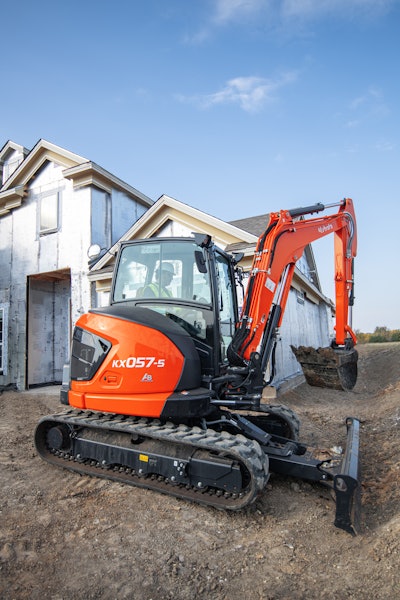 The Kubota KX057-5 is available with canopy or cab, rubber or steel tracks. Operating weight is up to 13,338 pounds with cab, steel tracks and optional angle blade. A 47.6-horsepower engine and two-speed travel are standard as are a 7-inch LCD color display with jog dial. Keyless start stores up to 10 user passcodes. HVAC vents have been increased from five to seven.Kubota
The Kubota KX057-5 is available with canopy or cab, rubber or steel tracks. Operating weight is up to 13,338 pounds with cab, steel tracks and optional angle blade. A 47.6-horsepower engine and two-speed travel are standard as are a 7-inch LCD color display with jog dial. Keyless start stores up to 10 user passcodes. HVAC vents have been increased from five to seven.Kubota
As with many compact machines, compact excavators tend to get a lot of different names. It can be a little confusing as to what defines a compact, a “mini” or a “midi” excavator.
We were hoping to find clarity of terms but we did not. It all depends on who’s talking.
Each respondent had insights into the definitions, but few of those insights corresponded with any others, revealing no wide consistency.
Some insisted “mini” and “compact” were synonymous and interchangeable. Others said “mini” was the small end of the compact classification for machines under 3 metric tons – or 4 to 5 metric tons, or up to 2 metric tons, depending on the source.
Some said “mini” and “compact” were the smaller models, and “midi” applied to those in the 8- to 10-metric-ton range.
At least one source said their company used all the terms, especially online. Because the market uses all these terms, it makes sense to include them in online communications to show up more often in online searches by potential customers.
The truth is, there is no uniformity in the use of terms. The best practice for avoiding confusion is to refer to machines’ operating weights by metric-ton class.
At Equipment World, we've mostly stuck with the term "compact excavator" for machines 10 metric tons and below.
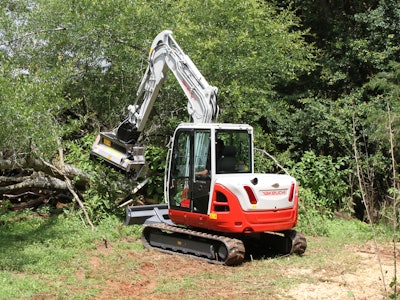 The Takeuchi TB370 has an operating weight of 14,850 pounds and a top travel speed of 2.9 mph with the standard two-speed drive. The swing boom angle is 79 degrees left and 51 degrees right. Hydraulic pressure is 3,550 psi and flow is 31.7 gallons per minute in the primary circuit and 12.3 gpm in the secondary. The Kubota V2607-CR-TE5B engine is rated at 56.9 horsepower.Takeuchi
The Takeuchi TB370 has an operating weight of 14,850 pounds and a top travel speed of 2.9 mph with the standard two-speed drive. The swing boom angle is 79 degrees left and 51 degrees right. Hydraulic pressure is 3,550 psi and flow is 31.7 gallons per minute in the primary circuit and 12.3 gpm in the secondary. The Kubota V2607-CR-TE5B engine is rated at 56.9 horsepower.Takeuchi

